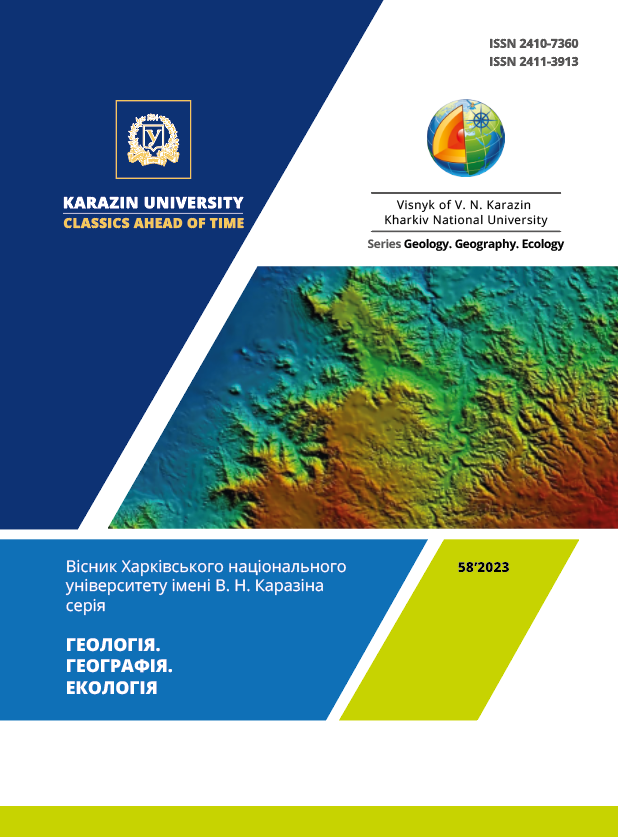Методика та практична імплементація дослідження зміни лісистості Волинської області із використанням методів ДЗЗ
Анотація
Ліси є невід’ємним компонентом навколишнього середовища, які виконують цілий ряд важливих екосистемних послуг. Серед них найголовнішими є підтримання рівня природності, екостабілізація, поглинання парникових газів. Проте в останні роки у Волинській області спостерігається тенденція до знеліснення. Основними причинами втрат були вирубка і знищення лісів шкідниками, хворобами і пожежами. В області відбуваються заходи лісовідновлення. Проте їх ефективність недостатня для запобігання знеліснення. За даним датасету Global Forest Watch відношення площ відновлених лісів до втрачених найменше у Маневицькому (14,7%), а найвище у Луцькому (73,3%) районах. В статті виконана спроба інтеграції даних з різних відкритих джерел (державної статистичної звітності, онлайн-платформ та веб-сервісів по моніторингу лісів, супутникових знімків) з метою оцінки сучасного стану лісів, динаміки їх площ, втрат лісів та лісовідновлення. Дані про площі лісів та знеліснення у Волинській, отримані з різних джерел, порівнювані між собою. Наприклад, за даними EOS Forest Monitoring площа лісів Волинської області у 2020 р. становила 1108,3 тис.га, за даними Global Forest Watch – 733 тис. га, за результатами визначення площі лісів в Google Earth Engine – 853 тис. га. Лісистість відповідно становила 55,02%, 36,38% і 42,35%. За офіційною інформацією з Екологічного паспорту області – 34%. Такі відмінності зрозумілі і пояснюються відмінністю в методиці визначення. Зростає площа нелісових земель лісогосподарського призначення. В 2017 р. їх площа становила 1692,3 га, в 2018 р. – 32459,3 га, в 2019 р. – 34136,86 га, в 2020 р. – 42436,33 га. Очевидно, що в 2018 р. відбулись зміни в підході до визначення цих земель. Зменшується площа загиблих лісових насаджень. Якщо в 2017 р. вона становила 2915 га, то в 2018 р. зменшилась на 43,01%, в 2019 р. – ще на 22,36%, в 2020 р. – ще на 33,22%. Найбільше гинули лісові насадження від шкідників і хвороб. Згадане вище зменшення площ пояснюється ефективними і значними за площами санітарними рубками в попередні роки. Площі лісів, що знищених пожежами, незначні. Втрати лісів відбувались внаслідок екстремальних погодних умов в окремі роки (2017 р, 2019 р.). Запропоновано комплекс заходів раціонального використання і охорони лісів у Волинській області.
Завантаження
Посилання
Multispectral methods of remote sensing of the Earth in the problems of nature management (2006). Ed. V.I. Lyalko. Kyiv, Naukova dumka, 360. [in Ukrainian]
Genyk, Y.V. (2011). Causes and consequences of deforestation and degradation of forest ecosystems in Ukraine. Scientific Bulletin of UNFU, 21, 118-122. [in Ukrainian]
Gensiruk, S.A. (2002). Forests of Ukraine. Lviv: Publishing House of the Scientific Society named after Shevchen-ko, 495. [in Ukrainian]
Karpyuk, Z.K., Fesyuk, V.O., Antipyuk, O.V. (2018). Nature reserve fund of the Volyn region. Catalog album. Kyiv: TOV Pidpryjemstvo VNA,140. [in Ukrainian]
Karpyuk, Z.K., Fesyuk, V.O. (2021).Nature reserve and ecological network of the Volyn region: monograph. Lutsk: Teren, 212. [in Ukrainian]
Melnyk, O.V., Manko, P.V. (2018). Classification of forests in Volyn based on multispectral satellite images. Inter-national scientific journal "ScienceRise", 9(50), 25-30. https://doi.org/10.15587/2313-8416.2018.143139 [in Ukrainian]
Melnyk, O.V., Manko, P.V. (2019). Classification of forested areas based on multispectral data. Modern technolo-gies and calculation methods in construction: collection of scientific works, 12, 112-122. https://doi.org/10.36910/6775-2410-6208-2019-2(12)-14. [in Ukrainian]
Ecological passports of the Volyn region for 2017-20. Electronic resource. Available at: https://voladm.gov.ua/category/ekologichni-pasporti/1/ [in Ukrainian]
Myronyuk, V.V., Bilous, A. M. (2017). Consistency of forest area estimates according to global forest change data and multispectral satellite image. Scientific Bulletin of UNFU, 27(5), 38-42. https://doi.org/10.15421/40270507 [in Ukrainian]
About the EOS Forest Monitoring product. Electronic resource. Available at: https://eos.com/uk/blog/eosda-zapuskaye-novij-servis-eos-forest-monitoring/ [in Ukrainian]
Results of visualization of the state of the forests of the Volyn region from the Global Forest Change dataset. Elec-tronic resource. Available at: https://glad.earthengine.app/view/global-forest-change#dl=3;old=off;bl=off;lon=
34126769060863;lat=51.76370582012041;zoom=8 [in Ukrainian]
Results of visualization of the state of the forests of the Volyn region on the GFW online platform. Electronic re-source. Available at: http://surl.li/cikpl [in Ukrainian]
Current ecological condition and prospects of ecologically safe sustainable development of Volyn region: collec-tive monograph. (2016). Ed. V.O. Fesyuk. Kyiv, TOV Pidpryjemstvo VNA, 316. [in Ukrainian]
Chaskovskyi, O.H., Hrynyk, H. G. (2020). Assessment of the loss of forest cover of the Ukrainian Carpathians by remote methods based on the materials of open sources of satellite information. Scientific Bulletin of UNFU, 30 (1), 66-73. https://doi.org/10.36930/40300111 [in Ukrainian]
Assessing Trends in Tree Cover Loss Over 20 Years of Data. Electronic resource. Available at: https://www-globalforestwatch-org.translate.goog/blog/data-and-research/tree-cover-loss-satellite-data-trend-nalysis/?_x_tr_sl=aur=uk&_x_=uk
Boisvenue, C., Smiley, B. P., White, J. C., Kurz, W. A., & Wulder, M. A. (2016). Integration of Landsat time series and field plots for forest productivity estimates in decision support models. Forest Ecology and Management, 376, 284-297. https://doi.org/10.1016/j.foreco.2016.06.022
Breiman, L. (2001). Random Forests. Machine Learning, 45, 5-32 https://doi.org/10.1023/A:1010933404324
Fedoniuk, M.A., Kovalchuk, I.P., Fesyuk, V.O., Kirchuk, R.V., Merlenko, I.M., Bondarchuk, S.P. (2021). Differences in the assessment of vegetation indexes in the EO-Browser and EOS LandViewer services (on the example of Lutsk district lands). Conference Proceedings, International Scientific Conference “Geoinformatics–2021”, May 2021. Electronic resource. Available at: https://eage.in.ua/?page_id=2414.
Global Forest Watch. “Fires in Volyn, Ukraine”. Electronic resource. Available at: www.globalforestwatch.org.
Hansen Global Forest Change v1.9 (2000-2021). Electronic resource. Available at: https://developers.google.com/earth-engine/datasets/catalog/UMD_hansen_ global_forest_change_2021_v1_9
Hansen, M.C., Potapov, P.V., Moore, R., Hancher, M., Turubanova, S. A., Tyukavina, A., Thau, D., Stehman, S. V., Goetz, S. J., Loveland, T. R., Kommareddy, A., Egorov, A., Chini, L., Justice, C. O. (2013). Supplementary Materials for High-Resolution Global Maps of 21st-Century Forest Cover Change. Science, 742, 850-853. https://doi.org/10.1126/science.1244693
Olofsson, P. Foody, G. M., Herold, M., Stehman, S.V., Woodcock, C.E., Wulder, M.A. (2014). Good practices for estimating area and assessing accuracy of land change. Remote Sensing of Environment, 148, 42-57. https://doi.org/10.1016/j.rse.2014.02.015
Weisse, M., Goldman, L. Forest Loss Remained Stubbornly High in 2021 (2021). Electronic resource. Available at: https://www.globalforestwatch.org/blog/data-and-research/global-tree-cover-loss-data-2021/

Цю роботу ліцензовано за Міжнародня ліцензія Creative Commons Attribution 4.0.





